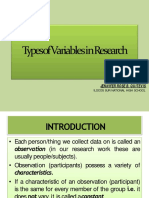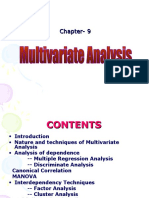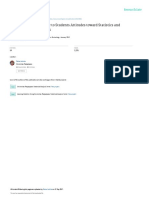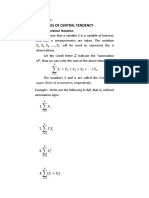Andale (2015, July 19) - Types of Variables in Statistics and Research. Retrieved From
Andale (2015, July 19) - Types of Variables in Statistics and Research. Retrieved From
Uploaded by
Jayson CandelariaCopyright:
Available Formats
Andale (2015, July 19) - Types of Variables in Statistics and Research. Retrieved From
Andale (2015, July 19) - Types of Variables in Statistics and Research. Retrieved From
Uploaded by
Jayson CandelariaOriginal Description:
Original Title
Copyright
Available Formats
Share this document
Did you find this document useful?
Is this content inappropriate?
Copyright:
Available Formats
Andale (2015, July 19) - Types of Variables in Statistics and Research. Retrieved From
Andale (2015, July 19) - Types of Variables in Statistics and Research. Retrieved From
Uploaded by
Jayson CandelariaCopyright:
Available Formats
Jayson B.
Candelaria 06-09-17
XII - Fleming
Types of Variables:
Control variable: one element that is not changed throughout an experiment, because its
unchanging state allows the relationship between the other variables being tested to be better
understood.
Dependent variable: the outcome of an experiment. What is being measured in an experiment
or evaluated in a mathematical equation
Discrete variable: can only take on a finite number of values are called "discrete variables." All
qualitative variables are discrete. Some quantitative variables are discrete, such as performance
rated as 1,2,3,4, or 5, or temperature rounded to the nearest degree.
Independent variable: a variable that is not affected by anything that you, the researcher,
does. Usually plotted on the x-axis.
Nominal variable: have two or more categories without having any kind of natural order. they
are variables with no numeric value, such as occupation or political party affiliation.
Ordinal variable: similar to a categorical variable, but there is a clear order. For example,
income levels of low, middle, and high could be considered ordinal.
Qualitative variable: are variables that are not numerical. It describes data that fits into
categories. For example: Eye colors (variables include: blue, green, brown, hazel).
Quantitative variable: represent a measurable quantity. For example, when we speak of the
population of a city, we are talking about the number of people in the city - a measurable
attribute of the city. Therefore, population would be a quantitative variable..
Ratio variables: interval variables, but with the added condition that 0 (zero) of the
measurement indicates that there is none of that variable.
Validity:
the degree to which an instrument measure what it is purports to measure. Invalid instruments
can lead to erroneous research conclusions, which in turn can influence educational decisions.
Validity in data collection means that your findings truly represent the phenomenon you are
claiming to measure.
Reliability:
is the degree to which an assessment tool produces stable and consistent results. Types of
Reliability. The internal consistency or stability of the measuring device over time.
Sources:
Andale(2015, July 19). Types of Variables in Statistics and Research. Retrieved from
http://www.statisticshowto.com/types-variables/
Poulenc(2017).Statistics How To
http://www.statisticshowto.com/qualitative-variable/
Phelan and Wren(2005). EXPLORING RELIABILITY IN ACADEMIC ASSESSMENT. Retrieved from
https://chfasoa.uni.edu/reliabilityandvalidity.htm
You might also like
- Multivariate Analysis – The Simplest Guide in the Universe: Bite-Size Stats, #6From EverandMultivariate Analysis – The Simplest Guide in the Universe: Bite-Size Stats, #6No ratings yet
- Introduction To Statistics and Data Analysis - 11Document47 pagesIntroduction To Statistics and Data Analysis - 11DanielaPulidoLunaNo ratings yet
- Variables in Research - 1,2 and 3-2Document16 pagesVariables in Research - 1,2 and 3-2saachinahataNo ratings yet
- PR2 Topic 4 - Variables and Scales of MeasurementDocument23 pagesPR2 Topic 4 - Variables and Scales of Measurementibrahim coladaNo ratings yet
- Types of VariablesDocument14 pagesTypes of VariablessanchezarchlaurenceNo ratings yet
- Types of Variables Grade 7Document32 pagesTypes of Variables Grade 7Jared Jome SobrevegaNo ratings yet
- Quantitative Techniques For Research: Ahmed ArifDocument11 pagesQuantitative Techniques For Research: Ahmed Arifuthmankheil89No ratings yet
- Types of Variables in ResearchDocument34 pagesTypes of Variables in ResearchPeterClomaJr.100% (1)
- Variables in ResearchDocument43 pagesVariables in ResearchRhino Balintong100% (1)
- Types of VariablesDocument31 pagesTypes of VariablesJane Dez MartinezNo ratings yet
- Hypothsis TestDocument2 pagesHypothsis TestKashinath MishraNo ratings yet
- Kaubos NG Pasensya L1 2 QRTR 1 PRDocument6 pagesKaubos NG Pasensya L1 2 QRTR 1 PRmustazaczarinahlaineNo ratings yet
- Module 04 - VariablesDocument32 pagesModule 04 - VariablessunnyNo ratings yet
- Prac VariablesDocument10 pagesPrac VariablesJen NailonNo ratings yet
- CHAPTER 1.1 Kind of Variables AutosavedDocument16 pagesCHAPTER 1.1 Kind of Variables AutosavedJohnlouie RafaelNo ratings yet
- Lesson 2 Types of Quantitative ResearchDocument38 pagesLesson 2 Types of Quantitative ResearchMargee GereroNo ratings yet
- Variable and Its Kinds: Grade 12 - Practical Research 2Document5 pagesVariable and Its Kinds: Grade 12 - Practical Research 2Jester Guballa de LeonNo ratings yet
- The Nature of VariablesDocument25 pagesThe Nature of Variablesmargilyn ramosNo ratings yet
- Kinds of Variables and Their UsesDocument16 pagesKinds of Variables and Their UsesArlene Lie FernandoNo ratings yet
- Introduction of StatisticsDocument14 pagesIntroduction of StatisticsKarl Andrei Peña100% (1)
- VariablesDocument14 pagesVariablesHero HijastroNo ratings yet
- 1Document6 pages1Clémentine AresNo ratings yet
- 4 Defining and Measuring VariablesDocument27 pages4 Defining and Measuring VariablesAsherah ShepherdNo ratings yet
- Data Collection ProcedureDocument47 pagesData Collection ProcedureJanice Pearl CuencaNo ratings yet
- PR2 NotesDocument9 pagesPR2 Notescali kNo ratings yet
- BBS 4th Year Report NotesDocument32 pagesBBS 4th Year Report Notesshashisinghrajput858No ratings yet
- Research TitleDocument6 pagesResearch TitleShaina Mae CaminocNo ratings yet
- Practical Research II 12 Q1 W3Document7 pagesPractical Research II 12 Q1 W3Kielah RequeNo ratings yet
- Variables in ResearchDocument5 pagesVariables in ResearchkhhhhsamimNo ratings yet
- Inquiries, Investigations, and ImmersionDocument36 pagesInquiries, Investigations, and ImmersionEricka ArceNo ratings yet
- The Variables in ResearchDocument4 pagesThe Variables in ResearchBryan Jester100% (2)
- Kinds of Variables - 22-23Document32 pagesKinds of Variables - 22-23Princess Daisy BrilataNo ratings yet
- Lesson 3 Variables in Quantitative ResearchDocument2 pagesLesson 3 Variables in Quantitative Researchgbs040479No ratings yet
- Probability and Statistics IIDocument12 pagesProbability and Statistics IIyusuforhan052No ratings yet
- BRM chp09Document41 pagesBRM chp09agarwalmonicaNo ratings yet
- Q1 PPT 4 VariablesDocument39 pagesQ1 PPT 4 VariablesjoshuaandreicsabellanoNo ratings yet
- Unit 4 Factor, Discriminant, Conjoint, Innovation-DiffusionDocument88 pagesUnit 4 Factor, Discriminant, Conjoint, Innovation-Diffusionkomalkataria2003No ratings yet
- Variables Kinds of Variables and Their UsesDocument37 pagesVariables Kinds of Variables and Their UsesIsagani Suguitan Jr.75% (4)
- STS 32643 - PPT - 02 - AjjDocument35 pagesSTS 32643 - PPT - 02 - AjjpraboddevNo ratings yet
- Unit IV Measurement and Scaling-1Document94 pagesUnit IV Measurement and Scaling-1onlinep410No ratings yet
- GEM 804 - Advance Engineering Statistic: Types of Variable and Level of MeasurementDocument14 pagesGEM 804 - Advance Engineering Statistic: Types of Variable and Level of MeasurementLeah Ann ManuelNo ratings yet
- RM Lesson 6Document24 pagesRM Lesson 6r236514gNo ratings yet
- Grade 12 - Practical Research 2 Q1W3Document8 pagesGrade 12 - Practical Research 2 Q1W3Glychalyn Abecia 23No ratings yet
- 2 Classification of VariablesDocument25 pages2 Classification of VariablesMa. Xynnah Rose R. HermosillaNo ratings yet
- Chapter TwoDocument4 pagesChapter TwoAHSAN JUTTNo ratings yet
- Practical Research 2Document24 pagesPractical Research 2Beneva Vega Malabanan100% (2)
- GEM 804 - Advance Engineering Statistic: Types of Variable and Level of MeasurementDocument14 pagesGEM 804 - Advance Engineering Statistic: Types of Variable and Level of MeasurementLeah Ann ManuelNo ratings yet
- Practical Research 2 Module 2 Q1Document9 pagesPractical Research 2 Module 2 Q1killersean dinerosNo ratings yet
- Research-3Document6 pagesResearch-3aaryamahale9114No ratings yet
- RM-Quantitative Data AnalysisDocument152 pagesRM-Quantitative Data AnalysisFarhana Zainol AbidinNo ratings yet
- Research Variables: Ayo Nelson BPHDocument25 pagesResearch Variables: Ayo Nelson BPHAYO NELSONNo ratings yet
- PR2 Kinds of Variables 2Document33 pagesPR2 Kinds of Variables 2Gan BenicoNo ratings yet
- Unit 2 Basic Statistical ConceptsDocument14 pagesUnit 2 Basic Statistical ConceptsHafizAhmadNo ratings yet
- 6461 Assignment No 2Document16 pages6461 Assignment No 2Muhammad SaleemNo ratings yet
- Introduction To Statistics and Research: John Ian Wilzon T. DizonDocument34 pagesIntroduction To Statistics and Research: John Ian Wilzon T. DizonAbdu MohammedNo ratings yet
- Practical Research 2 Module Week 3Document6 pagesPractical Research 2 Module Week 3jashminerosebardajeNo ratings yet
- Variables v2Document38 pagesVariables v2Honey Mae AlcarazNo ratings yet
- Variables: Prepared By: Belly Jane P. LarracasDocument23 pagesVariables: Prepared By: Belly Jane P. LarracasBellyJane LarracasNo ratings yet
- Variable S: Quantitativ eDocument40 pagesVariable S: Quantitativ eJames Valencia HensonNo ratings yet
- Research MethodologyDocument26 pagesResearch MethodologyApeksha D RaoNo ratings yet
- Variables: Prepared By: Belly Jane P. LarracasDocument19 pagesVariables: Prepared By: Belly Jane P. LarracasBellyJane LarracasNo ratings yet
- 3cl Candelaria ProfileDocument1 page3cl Candelaria ProfileJayson CandelariaNo ratings yet
- Shipborne Meteorological InstrumentsDocument59 pagesShipborne Meteorological InstrumentsJayson CandelariaNo ratings yet
- Biographical Context: A Thoughtful, Disciplined Reading of A Text. Also Called Close Analysis and Explication de TexteDocument3 pagesBiographical Context: A Thoughtful, Disciplined Reading of A Text. Also Called Close Analysis and Explication de TexteJayson CandelariaNo ratings yet
- Physical Characteristics of Saturn: Saturn Is A Gas Giant Made Up Mostly of Hydrogen and Helium Saturn Is BigDocument5 pagesPhysical Characteristics of Saturn: Saturn Is A Gas Giant Made Up Mostly of Hydrogen and Helium Saturn Is BigJayson CandelariaNo ratings yet
- GGGGGGGGGGGGGGGGGGGGGGGGGGGGGGGGGGGGGGGGGGGGGGGGGGGGGGGGGGGGGGGGGGGGGGGGGGGGGGDocument2 pagesGGGGGGGGGGGGGGGGGGGGGGGGGGGGGGGGGGGGGGGGGGGGGGGGGGGGGGGGGGGGGGGGGGGGGGGGGGGGGGJayson CandelariaNo ratings yet
- Nihongo FOR Every JuanDocument2 pagesNihongo FOR Every JuanJayson CandelariaNo ratings yet
- Circle of Life 1Document10 pagesCircle of Life 1Jayson CandelariaNo ratings yet
- The Servant SongDocument2 pagesThe Servant SongJayson Candelaria50% (4)
- DANEO 400 AppNote Testing SV Publishers With DANEO 400 2017 ENUDocument26 pagesDANEO 400 AppNote Testing SV Publishers With DANEO 400 2017 ENUImran WaheedNo ratings yet
- Abhinandan SahooDocument12 pagesAbhinandan SahooAbhinandan SahooNo ratings yet
- Aneja Convolutional Image Captioning CVPR 2018 PaperDocument10 pagesAneja Convolutional Image Captioning CVPR 2018 PaperajsocoolNo ratings yet
- Deep Network With Support Vector Machines: Abstract. Deep Learning Methods Aims at Learning Features Automatically atDocument2 pagesDeep Network With Support Vector Machines: Abstract. Deep Learning Methods Aims at Learning Features Automatically atAsil AsilaNo ratings yet
- Isatis Case Studies MiningDocument236 pagesIsatis Case Studies Miningrenzoquim100% (1)
- Role of Statistics in Engineering A Review IJERTV11IS100057Document6 pagesRole of Statistics in Engineering A Review IJERTV11IS100057devraj10010713No ratings yet
- Quetions For Top Students PDFDocument2 pagesQuetions For Top Students PDFharuhi.karasunoNo ratings yet
- 785260Document8 pages785260Abhishesh J. PandeyNo ratings yet
- StatisticsandProbability Week8Document6 pagesStatisticsandProbability Week8Angel TubatNo ratings yet
- Session 11 HandoutsDocument37 pagesSession 11 HandoutsFUDANI MANISHANo ratings yet
- The Effect of SPSS Course To Students Attitudes Toward Statistics and Achievement in StatisticsDocument5 pagesThe Effect of SPSS Course To Students Attitudes Toward Statistics and Achievement in StatisticsAilyn del PuertoNo ratings yet
- Course Out Line Research MethodsDocument5 pagesCourse Out Line Research MethodsZelalem HassenNo ratings yet
- The Optimal Bandwidth For Kernel Density Estimation of Skewed Distribution: A Case Study On Survival Time Data of Cancer PatientsDocument9 pagesThe Optimal Bandwidth For Kernel Density Estimation of Skewed Distribution: A Case Study On Survival Time Data of Cancer PatientsAbdul RahmatNo ratings yet
- Data Mining: Bob Stine Dept of Statistics, Wharton School University of PennsylvaniaDocument21 pagesData Mining: Bob Stine Dept of Statistics, Wharton School University of Pennsylvaniaajax_telamonioNo ratings yet
- Q - PalmrDocument55 pagesQ - PalmrGwenn SalazarNo ratings yet
- Processes-I: Unit 7 RenewalDocument13 pagesProcesses-I: Unit 7 RenewalPrabin SilwalNo ratings yet
- @vtucode - in Module 4 AI 2021 Scheme 5th SemDocument11 pages@vtucode - in Module 4 AI 2021 Scheme 5th SemRatan ShetNo ratings yet
- Basic Concepts of ProbabilityDocument112 pagesBasic Concepts of ProbabilityNo FreedomNo ratings yet
- Segmen 10 Mode Choice - Choice ModellingDocument6 pagesSegmen 10 Mode Choice - Choice ModellingMeikhaErfaridaFitriNo ratings yet
- Ch. 3 - Central TendencyDocument12 pagesCh. 3 - Central TendencySahara MalabananNo ratings yet
- Single Vs Multiple Sets of Resistance Exercise For Muscle Hypertrophy A Meta AnalysisDocument10 pagesSingle Vs Multiple Sets of Resistance Exercise For Muscle Hypertrophy A Meta AnalysisaliNo ratings yet
- Bbs Project Work BRICK INDUSTRYDocument14 pagesBbs Project Work BRICK INDUSTRYPADAM THAPANo ratings yet
- Analysis of Variance AnovaDocument38 pagesAnalysis of Variance AnovahidaNo ratings yet
- QTDM 2Document3 pagesQTDM 2pranaviNo ratings yet
- Kang Chen 2023 The Effect of Fiscal Stress Labels On Local Governments Financial Management Evidence From New YorkDocument36 pagesKang Chen 2023 The Effect of Fiscal Stress Labels On Local Governments Financial Management Evidence From New YorkevikrismayantiNo ratings yet
- Selection Bias (Heckman-SPSS)Document9 pagesSelection Bias (Heckman-SPSS)rbmalasaNo ratings yet
- IBA SYLLABUS AAMD FawadDocument5 pagesIBA SYLLABUS AAMD FawadAshar Zia100% (1)
- Kelompok 12 - Article SummaryDocument22 pagesKelompok 12 - Article SummaryRahma HumairahNo ratings yet
- Tests, Chi-Squares, Phi, Correlations: It's All The Same StuffDocument2 pagesTests, Chi-Squares, Phi, Correlations: It's All The Same StuffNejash Abdo IssaNo ratings yet

































































































